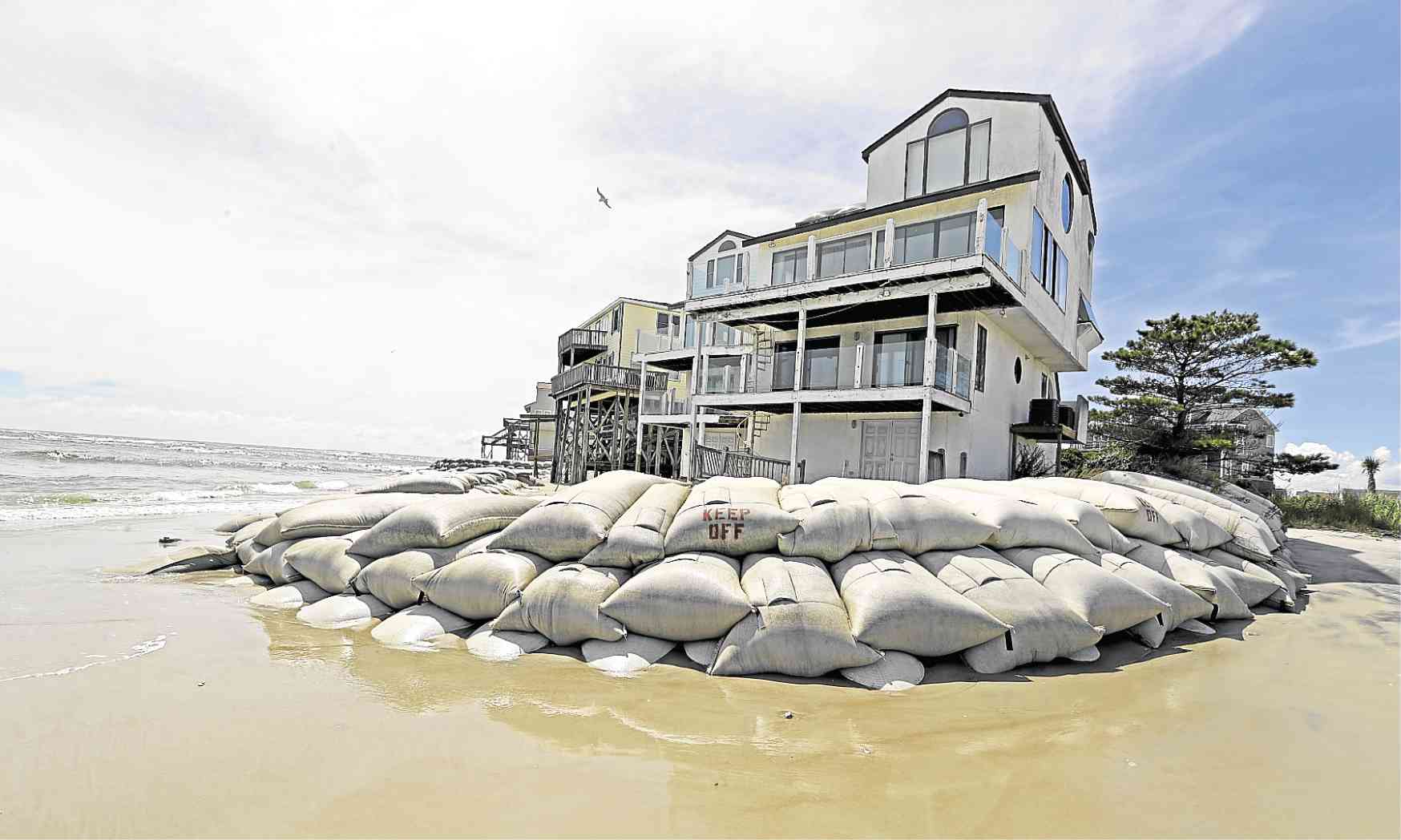10M in crosshairs of Hurricane ‘Florence’

HURRICANE THREAT Sandbags surround homes in North Topsail Beach, North Carolina, on Wednesday as Hurricane “Florence” threatens the US southeast coast. —AP
MYRTLE BEACH, SOUTH CAROLINA—Time is running short to get out of the way of Hurricane “Florence,” a monster of a storm that has a region of more than 10 million people in its potentially devastating sights as it zeroes in on the US southeast coast.
Forecasters said wind speeds had dropped from a high of 225 kilometers per hour to 175 kph, reducing it from a Category 4 storm to a Category 2 one, and additional fluctuations and weakening were likely as it swirled toward land.
According to authorities, however, Florence still has an enormous wind field that has been growing larger, raising the risk of the ocean surging on to land and making the hurricane extremely dangerous.
“Do you want to get hit with a train or do you want to get hit with a cement truck?” said Jeff Byard, an administrator with the Federal Emergency Management Agency.
The National Hurricane Center’s best guess was that Florence would blow ashore as early as Friday afternoon around the North Carolina-South Carolina line, then slog its rainy way westward with a potential for catastrophic inland flooding that could swamp homes, businesses and farm fields.
Article continues after this advertisementAbout 5.25 million people live in areas under hurricane warnings or watches, and 4.9 million live in places covered by tropical storm warnings or watches, according to the National Weather Service.
Article continues after this advertisementWater kills more people
Weather Underground meteorology director Jeff Masters said Florence eventually could strike as a Category 1 hurricane with winds less than 160 kph, but that could still cause at least $1 billion in damage.
Water kills more people in hurricanes than wind, and Masters said Florence would still be an extremely dangerous storm for rain and storm surge.
The hurricane center is forecasting the storm to hover near the coast on Saturday with winds of around 130 kph before landfall, but with rainfall ranging from 50 to 75 centimeters and up to 4 meters of storm surge.
US President Donald Trump touted the government’s readiness and urged people to get out of the way. “Don’t play games with it. It’s a big one,” he said at the White House.
On Thursday morning, Florence was spotted 378 km east southeast of Wilmington, North Carolina, and about 450 km east southeast of Myrtle Beach, South Carolina, moving northwest at 28 kph.
The hurricane center said Florence would approach the coast on Friday and linger for a while before rolling ashore.
1.7M told to clear out
It was unclear exactly how many people fled, but more than 1.7 million people in the Carolinas and Virginia were warned to clear out. Airlines had canceled nearly 1,000 flights and counting.
Home Depot and Lowe’s activated emergency response centers to get generators, trash bags and bottled water to stores before and after the storm. The two hardware chains said they had sent in a total of around 1,100 trucks.
Duke Energy, the nation’s No. 2 power company, said Florence could knock out electricity to three-quarters of its 4 million customers in the Carolinas, and outages could last for weeks.
Workers are being brought in from the Midwest and Florida to help in the storm’s aftermath, the company said.
Boarding up his home in Myrtle Beach, South Carolina, Chris Pennington monitored the forecasts and tried to decide when to leave. “In 12 or 18 hours, they may be saying different things all over again,” he said.
Computer models of exactly what the storm might do varied, adding to the uncertainty.
‘Exceptionally bad news’
Reacting to the possibility of a more southerly track, Georgia Gov. Nathan Deal declared an emergency but did not immediately order any evacuations.
In Virginia, where about 245,000 residents were ordered to evacuate low-lying areas, officials urged people to remain away from home despite forecast changes showing Florence’s path largely missing the state.
Forecasters worried the storm’s damage would be all the worse if it lingered on the coast.
The trend is “exceptionally bad news,” said University of Miami hurricane researcher Brian McNoldy, since it “smears a landfall out over hundreds of miles of coastline, most notably the storm surge.”
With South Carolina’s beach towns more in the bull’s-eye because of the shifting forecast, Ohio vacationers Chris and Nicole Roland put off their departure from North Myrtle Beach to get the maximum amount of time on the sand. Most other beachgoers were long gone.
“It’s been really nice,” Nicole Roland said. “Also, a little creepy. You feel like you should have already left.” — AP